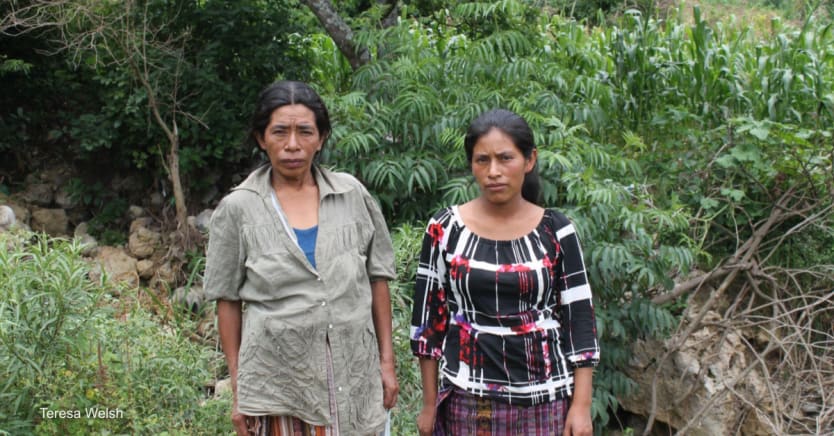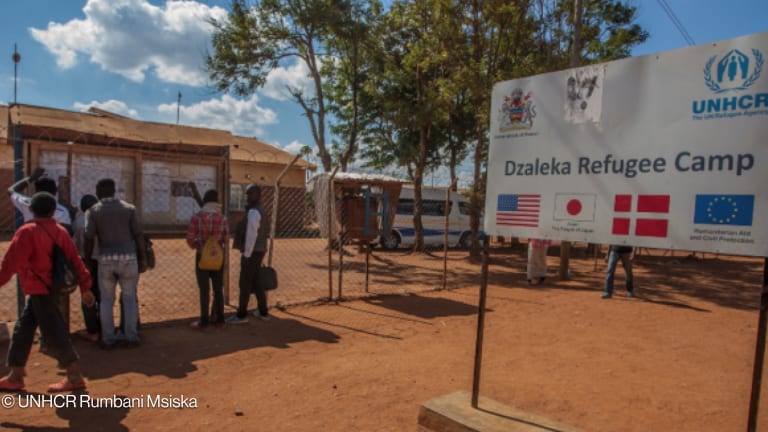
SANTA MARÍA CUNÉN, Guatemala — The night the landslide came, María Quip Us was at home with three of her children in their mountainside community of La Pedrera, just outside the city of Cunén in Guatemala’s western highlands. The rains had been falling for weeks when Hurricane Iota blew over Central America.
The storm hit in November, less than two weeks after Hurricane Eta, which also dumped rain on this landlocked area in the department of Quiché. The inundation from two hurricanes was too much for the land to absorb, causing dozens of landslides across the country as earth slid away from the mountainside onto towns and roads below.
In La Pedrera, the landslide began around midnight. Quip Us, who was seven months pregnant, was able to escape with her family. Six months later, their home remained unusable, still filled with dried mud and debris.
The family is currently living in a home shared with others who were displaced by the hurricanes, paying only the electricity bill to the owner, who is otherwise allowing them to stay there temporarily for free. Quip Us said her children are traumatized from the disaster. Her youngest daughter is no longer able to sleep if it’s raining outside, afraid they are in danger even though the temporary home is further from the mountainside.

The family’s welcome in the home is expiring even as Quip Us has no other options. Her husband had to migrate to another department within Guatemala to find work, but he doesn’t earn enough for them to relocate or purchase a new plot of land.
“Where would we go? We have nowhere else to go,” said Quip Us, who lost her pregnancy after the landslide due to the trauma and stress.
Nearly 2 million Guatemalans found themselves in similar situations after the two hurricanes battered the country. Strong winds and rains destroyed homes and schools, washed out roads and bridges, and flooded agricultural fields.
Now, many communities are still struggling to recover, with resources to rebuild homes and replant fields scarce and food insecurity on the rise. More than a quarter of a million people have also been affected by flooding this year as the rainy season began again in May, further complicating the recovery.
Without enough support to rebuild their lives and reestablish livelihoods, leaving the country altogether can often be the only option for those affected by disasters, who have also increasingly been contending with the effects of climate change.
First the pandemic, then the storms
The twin disasters came during the COVID-19 pandemic, which left many who labor in the informal economy unable to make enough money to meet basic needs.
“People lost so much because all of the crops were destroyed in many areas. More than talking about food security, it’s talking about surviving,” said Angel Tecúm, administrative coordinator with Caritas in Guatemala. “Right now, they’re not looking to eat something nutritious but to eat anything at all.”
The storms’ impact on subsistence farming has left more than 427,000 people in phase 4 of the Integrated Food Security Phase Classification system, or at emergency levels. That figure is nearly three times higher than the estimate before Eta and Iota, according to the United Nations Office for the Coordination of Humanitarian Affairs.
“The reality in Central America is that people who don’t have work, or don’t have any way to make a living, or have lost everything — they’re left with no other option than to migrate.”
— Edy Iquique, Guatemalan Red Cross migration programIn Quiché, many farmers plant only corn, Tecúm said. This monocultivation leaves them not only susceptible to crop loss, but also to malnutrition because they do not have access to an affordable, nutritious diet.
Some communities were isolated after the storms destroyed roads, preventing them from receiving additional food and other vital supplies. According to Tecúm, some areas were inaccessible for as long as three months.
The government — which is also contending with pandemic response — is largely absent as communities try to rebuild.
“There’s been nothing,” Quip Us said of any government assistance. Nongovernmental organizations have been responding, providing emergency food assistance and other humanitarian supplies. The U.S. Agency for International Development deployed a disaster assistance response team in November after the storms hit and another in April as humanitarian needs remained elevated. The U.S. also announced an additional $54 million in assistance to Guatemala in April.
Residual trauma from the storms has also had an adverse impact on families’ ability to maintain their income and food sources.
Paulina Margarita Luz Martín lost two children in a landslide after Hurricane Eta when the mud swept through her grandparents’ house in Trigales, a community close to La Pedrera, where the children had been spending the night. Everyone in her family remains traumatized and blames themselves for the children’s deaths, causing them to neglect their plot of land on which they grow basic crops such as beans and onions. She said their last planting cycle did not yield as successful a harvest as usual.
They also lost a piece of their agricultural land to debris from the landslide, unable to return it to cultivation.

‘It has changed completely’
In addition to the short-term disruptions caused to agriculture by the storms, climate change has increasingly been impacting producers in this part of Quiché. According to the Global Climate Risk Index 2021, Guatemala is affected by extreme weather events on a regular basis.
Just a decade ago, there used to be occasional droughts with rain stopping for a week or two, according to Tecúm.
“Now it has changed completely,” Tecúm said, noting that rain can stop altogether for a month or more. “Now the seasons aren’t as set as they were before. … It’s totally variable. Before, it was the same every day.”
Drought is especially bad for farmers if it comes right after they’ve planted their seeds, preventing them from successfully taking root. Farmers often cannot afford to replant because they do not have funds to repurchase seeds.
Many farmers in Quiché use traditional farming practices, Tecúm said, and their techniques have not adapted to challenges posed by climate change. There is only one harvest annually, while weather patterns in other parts of the country allow for up to three harvests per year. This makes people in the region more susceptible to food insecurity, he said.

These compounding circumstances — natural disaster on top of chronic food insecurity on top of worsening climate change on top of the pandemic — make remaining at home increasingly untenable for people.
A recent study by Catholic Relief Services surveyed Guatemalans across the country, including in Quiché, about what factors contribute to a decision to migrate or stay in one’s community of origin. According to the study, migratory flows to the U.S. are increasingly coming from rural areas, where crop and livelihood loss, food insecurity, and exposure to climate change and extreme weather — all conditions currently seen in Quiché — will only further contribute to future migration.
The study found a “significant link” between the effects of natural disasters, such as droughts and floods, and food insecurity and migratory intent.
It also found that migration is one of the main coping strategies when people do not have sufficient owned land, investments in irrigation systems and other inputs to improve production remain prohibitively expensive, there is no access to formal credit under favorable conditions, and most daily labor has a precarious and informal nature. Families in crisis situations consider migrating even more intensely, according to CRS.
People in those crisis situations also have a harder time accessing services they might need, according to Edy Iquique with the migration program of the Guatemalan Red Cross.
“Many people lost everything — their livelihoods, homes, work, health, education — and many of them decided that they had to look for other options,” Iquique said. “The reality in Central America is that people who don’t have work, or don’t have any way to make a living, or have lost everything — they’re left with no other option than to migrate.”






